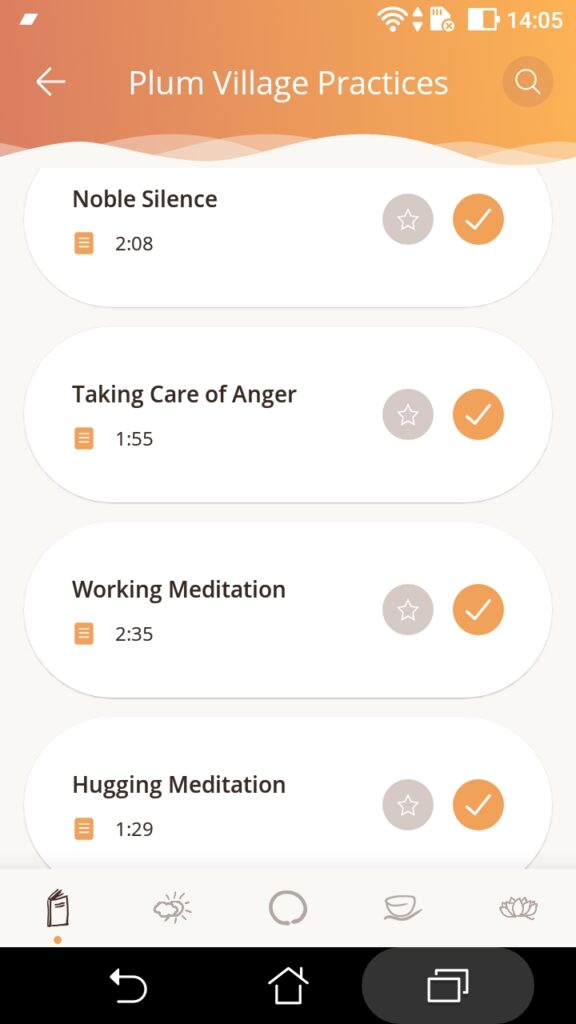Did you know that all the main Plum Village practices can be found in one place, on the Plum Village App?
Go to Resources and click on Plum Village Practices – this essential practices folder goes hand in hand with the Start Here folder previously discussed here.
Though aimed at beginners, this folder is a good resource for seasoned practitioners too. At its core is written material, which makes explanations and instructions easily accessible as you familiarise yourself with the practices and start developing your daily mindfulness routine in the Plum Village tradition.
Thich Nhat Hanh’s guidance
This material encapsulates the wisdom of Zen Master Thich Nhat Hanh, with most of the selected texts being excerpts from Thay’s many books, Dharma Talks, and teachings – as well as including insights from his disciples, dharma teachers in the Plum Village tradition. The texts cover some of the main types of meditation:
This meditation is a celebration of being alive. We celebrate with our breathing: breathing in and breathing out. We enjoy our lungs, our back, our heart, with every in-breath and out-breath. It’s important to allow your body to relax completely.
Wherever we walk, we can practice meditation. This means that we know that we are walking. We walk just for [the sake of] walking. We walk with freedom and solidity, no longer in a hurry. We are not lost in thinking about what has just happened or what will happen later, or tomorrow. With each step, we are fully present in the here and now.
Sometimes people ask, ‘How do we know we’re working in mindfulness?’ If you’re aware of your body and breathing, then you’re working in mindfulness. If you are able to gladden your mind, and keep a relaxed posture and lightness in your actions, then you are working with the ease of right mindfulness.
Hugging with mindfulness and concentration can bring reconciliation, healing, understanding, and much happiness. The practice of mindful hugging has helped many people to reconcile with each other: fathers and sons, mothers and daughters, friends, and many others.
Feelings come and go like clouds in a windy sky. Conscious breathing is my anchor
Thich Nhat Hanh
Our breathing is a stable, solid ground where we can always take refuge. Regardless of what is going on inside or around us, our breathing is there for us like a faithful friend. One mindful in-breath is enough to bring the mind home to the body, making us become fully present, fully alive.
This is an opportunity to benefit from each other’s insights and experience of the practice. It is a special time to share our experiences, our joys, our difficulties, and our questions relating to the practice of mindfulness. By practicing deep listening while others are speaking, we help create a calm and receptive environment. By learning to speak out about our happiness and our difficulties in the practice, we contribute to the collective insight and understanding of the sangha.
The only antidote for anger, for violence, is compassion. And so the question is, ‘How do we generate compassion?’ We generate compassion by understanding suffering – our own suffering, and the suffering of those whose actions or words have hurt us. It may take some time to look into the situation deeply.
In Plum Village practice centers, we observe a period of deep silence, from the end of the evening sitting meditation until after breakfast the next morning. This is very healing. The Buddha made it very clear that being alone, being quiet, does not mean having to go to the forest. You can live in the community, you can be in the city or town, yet still enjoy silence and solitude. This is something we all have to learn.
This is a day to truly rest and relax without any scheduled activities. Just let the day unfold naturally, timelessly. It’s a chance to truly stop and look deeply into ourselves and our relationships. In Plum Village we also practice ‘no car’ days, ‘no computer’ days and ‘no internet’ days.

The bell
As one of the few objects central to the practice, the bell gets special attention, with video material explaining its role in the practice of mindfulness. In one video, Brother Phap Huu explains how to invite the bell; in another, Sister Dang Nghiem practices with it.
The glossary
To make it easier to navigate the above-mentioned texts and other material on the app, you can also access a glossary which includes special concepts and terms, especially those deriving from Sanskrit, but also short definitions of common words, such as “discourse”, in the context of Buddhist teachings.
Beginning anew
In a short video teaching, Brother Bao Tang introduces us to Beginning Anew – a four-step practice that helps us clear up the wrong perceptions in our relationships through deep communication. This is not a technique but a way of being mindful, concentrating, and of fostering calm, compassion, and love in our relationships. It’s important to familiarize yourself with it early in your mindfulness journey.
As a Plum Village App user, you already know that we update the material on the app almost daily, so watch this space for more essential practices.
You can explore the Plum Village practices folder in parallel with the Start Here folder, where you can find audio and video guided meditations and further insights into the practice.
Next? Try the Key Texts folder.
Enjoy!
☁️ As has been the case with Buddhist teachings for millennia, there is no charge for the Plum Village App and its digital content. However, if your means allow, please consider offering a donation to support our small team’s continued work on the app.
